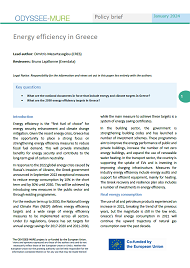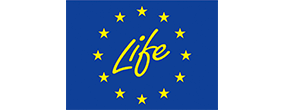Summary
Key questions
- What are the national documents in force that include energy and climate targets in Greece?
- What are the 2030 energy efficiency targets in Greece?
Lead authors: Dimitris Mezartasoglou (CRES)
Reviewers: Bruno Lapillonne (Enerdata)
Introduction
Energy efficiency is the “first fuel of choice” for energy security enhancement and climate change mitigation. Given the recent energy crisis, Greece has the opportunity to place a strong focus on strengthening energy efficiency measures to reduce fossil fuel demand. This will provide immediate benefits for energy security and contribute to the long-term goal of carbon neutrality.
In response to the 2022 global energy crisis caused by Russia’s invasion of Ukraine, the Greek government announced in September 2022 exceptional measures to reduce energy consumption by 10% in the short term and by 30% until 2030. This will be achieved by introducing new measures in the public sector and through existing programmes.
For the medium term up to 2030, the National Energy and Climate Plan (NECP) defines energy efficiency targets and a wide range of energy efficiency measures to be implemented across all sectors. Under EU regulations, Greece has set targets for annual energy savings for 2017-2020 and 2021-2030, while the main measure to achieve these targets is a system of energy saving certificates.
In the building sector, the government is strengthening building codes and has launched a number of investment schemes. These programmes aim to improve the energy performance of public and private buildings, increase the number of net zero energy buildings, and expand the use of renewable water heating. In the transport sector, the country is supporting the uptake of EVs and is investing in improving charging infrastructure. Measures for industry energy efficiency include energy audits and support for efficient equipment, mainly for heating. The Greek recovery and resilience plan also includes a number of investments in energy efficiency.
Final energy consumption
The use of oil and petroleum products experienced an increase in 2021, breaking the trend of the previous years, but the magnitude is still in the low ends. Greece’s final energy consumption in 2021 will continue the upward trajectory of natural gas consumption over the past decade.
It is impossible to ignore the growing significance of renewable energy’s contribution to final energy consumption, as it remains in third position with a 12.3% share. In terms of final energy consumption, the shares of oil products have remained largely steady throughout the last decade, with oil and petroleum leading the energy consumption. The overall increase in Greece’s final energy consumption in 2021 compared to 2020 is 3.1% (Figure 1).
Figure 1: Final Energy Consumption by Product in Greece (ktoe), [Avg. 2012-2017 up to 2021]
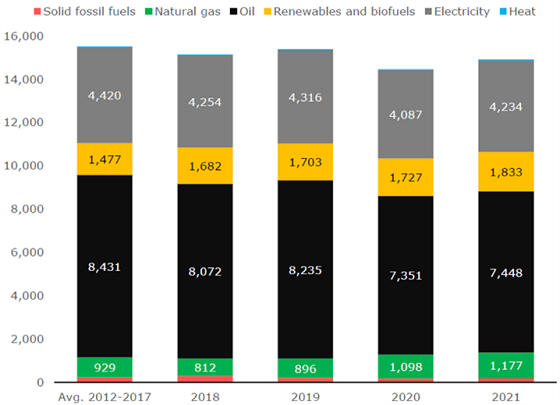
Source: Eurostat
After the recovery from the pandemic in 2021, most of the end-use sectors experienced an increase in final energy consumption, the highest being in transport (8% in 2021 after a 15% decrease in 2020); transport consumption in 2021 was still below the 2010-2019 average. Final consumption in the household sector stagnated in 2021 (Figure 1). Final energy consumption for industry, which had been decreasing significantly since 2011, had a slight increase of about 2% in 2021. Consumption of services increased by 7% in 2021, after an 11% decrease in 2020 and a rise between 2014 and 2017.
Figure 2: Final Energy Consumption per Sector in Greece (ktoe), 2010-2021
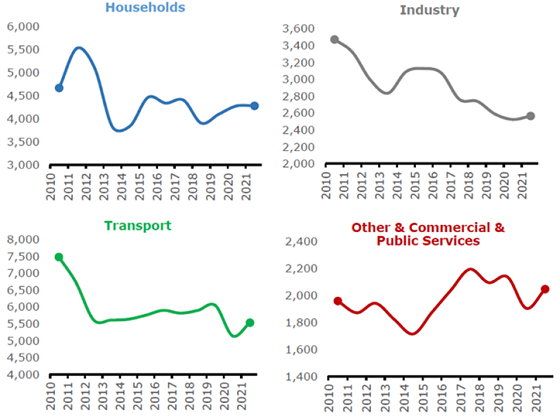
Source: Eurostat, HAEE
Energy efficiency targets and status
In Greece, the NECP of December 2019 is still in force, but the draft updated version was sent to the European Commission in November 2023 for comments. For the medium term up to 2030, the NECP defines energy efficiency targets (Figure 3) and a wide range of energy efficiency measures to be implemented across all sectors.
While Greece successfully implemented some energy efficiency policies up to 2020, most of the reduction in energy demand over this period resulted from the negative impacts of Greece’s prolonged economic contraction and the Covid-19 pandemic. Greece’s Primary Energy Consumption (PEC) and Final Energy Consumption (FEC) have been decreasing considerably since 2008, with their lowest levels recorded in 2020 (Figure 1). Although PEC and FEC increased in 2021, they were still below 2019 levels. In 2021, Greece’s PEC and FEC were below the levels set for the 2020 targets, reflecting the government’s goal of achieving strong economic growth and improving energy efficiency and keeping energy consumption flat.
Figure 3: Greece’s 2020 and 2030 Energy Efficiency Targets and Status, 2005-2021
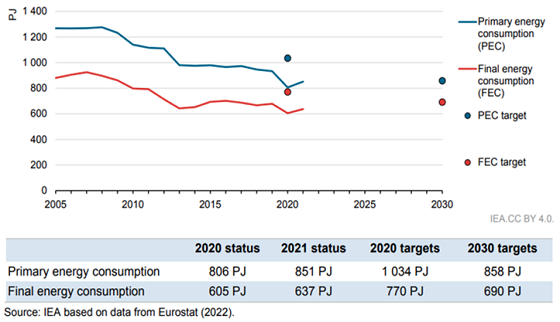
Source: Eurostat, IEA
Progress to energy efficiency targets in Greece
The updated version of Greece’s NECP sets a target of no more than 15.4 Mtoe in final energy consumption in 2030 (Figure 1), which is 7% below the target of the previous NECP for the same year (16.5 Mtoe). Primary energy consumption is expected to reach 18.2 Mtoe in 2030, a decrease of 11% compared to the target set in the previous NECP. Greece is making progress, but continued efforts are needed to achieve its 2030 energy efficiency targets.
Table 1: Energy efficiency data in Greece

Source: Greece’s Ministry of the Environment and Energy, 2023
The continuous improvement of energy efficiency in all sectors is the second pillar, just as important as RES, which underpins the energy transition. Therefore, the target of maintaining final energy consumption in 2030 at 2021 levels requires targeted energy saving actions to be implemented in the buildings sector, i.e. dwellings and buildings in the tertiary sector. This sector needs to reduce final energy consumption in 2030 by about 15% compared to 2021 to offset the expected increase in energy consumption in the industry and transport sectors.
Equally important is the contribution from the replacement of appliances with higher efficiency technologies, the energy improvement of lighting, especially in the public sector and street lighting, and the acceleration and expansion of energy upgrades in public sector buildings.
The vital role of Greece’s Energy Efficiency Obligation Scheme (EEOS)
Under Article 7 of the EED, Greece had a target of cumulated energy savings of 3,333 ktoe or 140 PJ between 2017 and 2020. In its National Energy Efficiency Action Plan of 2017, the government indicated a number of measures in different sectors to meet this target. Data on achieved energy savings show that the Energy Efficiency Obligation Scheme (EEOS) in Greece reached 61.4 PJ of cumulated energy savings and, thus, we can understand the importance of such a scheme in terms of achieving the aforementioned target of cumulated energy savings (140 PJ).
Greece’s Energy Efficiency Obligation Scheme (EEOS) started in 2017 and is managed by the CRES. Obligated parties are electricity, gas, and oil product suppliers or retailers whose market share is higher than 1%. The number of obligated parties was 35 in 2022. From 2017 to 2020, the EEOS exceeded its target demand reduction by 80%, with annual savings growing from 7.3 PJ to 36 PJ.
A new cycle of energy savings is expected under the EED for EU countries from 2021 to 2030. Greece is expected to achieve cumulative energy savings of 7,299 ktoe or 305 PJ by the end of this period.
This energy savings objective will be attained by combining energy efficiency obligation schemes with a mix of alternative policy measures. More specifically, energy efficiency obligation schemes will account for 20% of the total cumulative objective for 2021-2030, whereas a total of nine alternative policy measures will be implemented to cover the remaining part of the objective, reflecting the key policy priorities and the most important energy efficiency improvement measures.
Financing energy efficiency programmes in Greece
In response to the Covid-19 pandemic, the European Union established the Recovery and Resilience Facility, which provides €724 billion throughout 2026 to support recovery and resilience plans developed by each EU member state.
Greece was among the first EU member states to submit a plan, in April 2021. The plan (Greece 2.0) is one of the largest funding requests to the Recovery and Resilience Facility (€30.5 billion, equivalent to 16.7% of Greece’s 2019 GDP). The plan funds energy efficiency subsidies for residential buildings (€1.1 billion), businesses (€0.45 billion), and the public sector (€0.2 billion). In the electricity sector, there is funding to deploy 1.4 GW of electricity storage (€0.45 billion), interconnect the islands (€0.2 billion), and upgrade electricity distribution networks (€0.1 billion). The plan also includes €0.2 billion to install 8,656 publicly accessible EV charging points, deploy 220 electric buses, and replace older taxis with EVs. The plan further includes €0.3 billion for energy research, development and demonstration (RD&D) relating to EVs, and the development of Greece’s first CO2 storage facility.
The plan also supports the implementation of a variety of energy sector reforms, including improvements to the main financing mechanism for renewables and co-generation and to licensing and spatial planning for renewables.
In November 2023, the Commission positively assessed Greece’s modified Recovery and Resilience Plan, which includes a REPowerEU chapter, and the plan is now worth €35.95 billion. Most notably, the newly added and scaled-up reforms and investments included in the REPowerEU chapter strongly contribute to the energy transition.
Overall, they reinforce the ambition to decarbonise the economy by increasing energy efficiency and renewable capacity. The reforms aim, among others, to introduce new non-grant based financial instruments to further support energy efficiency investments for households, businesses, and the tertiary sector and to support energy efficiency measures, including the installation of solar water heaters and renovations, and the promotion of renewables for self-consumption.
The investments to be financed in the field of energy efficiency in Greece include five different sub-programmes, which are described in Figure 4.
Figure 4: Financing Energy Efficiency Programmes in Greece through RRF
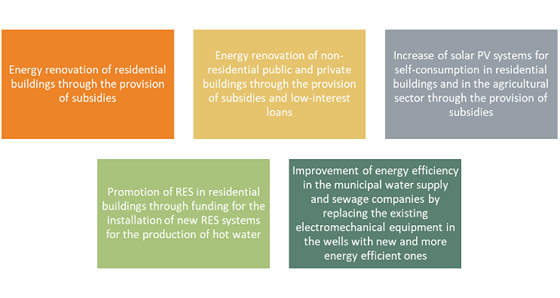
Source: Greece’s Recovery and Resilience Plan
